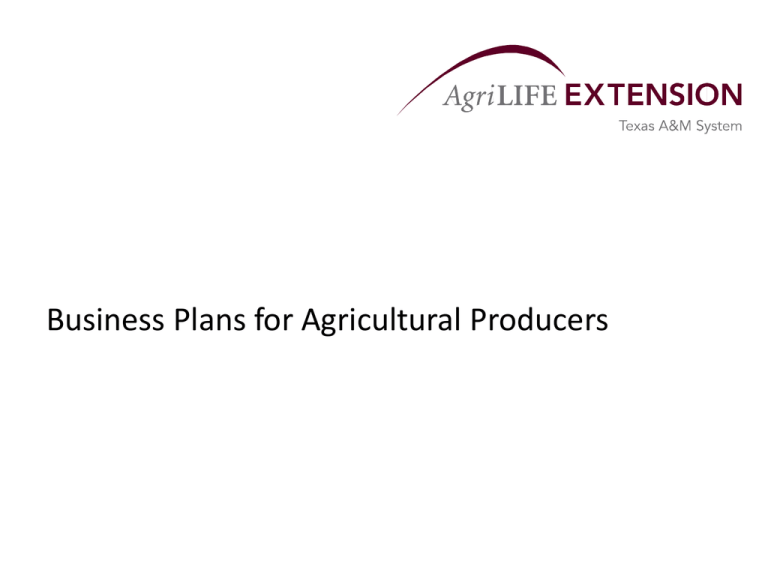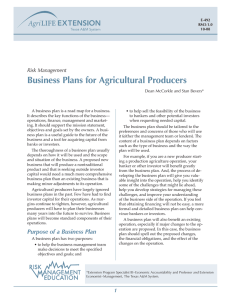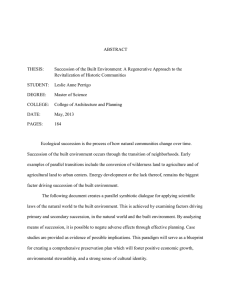Business Plans for Agricultural Producers
advertisement

Business Plans for Agricultural Producers General Information A business plan is a road map for a business. It describes the key functions of the business – operations, finance, management, and marketing. It should support the mission statement, objectives and goals set by the owners. A business plan is a useful guide to the future of the business and a tool for acquiring capital from banks or investors. The business plan should be tailored to the preferences and concerns of those who will use it. The content of a business plan depends on factors such as the type of business and the way the plan will be used. Purposes of a Business Plan To help the business management team make decisions to meet the specified objectives and goals. To help sell the feasibility of the business to bankers and other potential investors when requesting needed capital. Components of a Business Plan Business Description History and location Products and services Organizational structure Resource inventory Human Land Equipment Capital Commodities Natural Resources Strengths, weaknesses, opportunities and threats (SWOT) Mission Statement Objectives and Goals Production Plan Financial Plan Market Plan Legal and Liability Issues Insurance Succession and estate planning Business Description and Organization It describes the history and location of the business, the products produced and/or services provided, the organizational structure, and resources the business has and needs. It also summarizes the business’s strengths, weaknesses and opportunities, and threats the business may face. Organizational structure explains: 1) whether the business is a sole proprietorship, limited or general partnership, corporation, or other form of organization; and 2) who comprises the management team. Mission Statement, Objectives and Goals A mission statement is a broad expression of the business’s purpose. A business plan must define why the business exists and where the management wants it to be in the future. An effective mission statement is the foundation for determining objectives and goals and steering the business in the proper direction. The objectives and goals can relate to production, production costs, debt ratios, risk management, expansion, bringing a partner into the business, or any other aspect of the business. Objectives define what the operation will look like in the future, while goals are targets to be met in order to achieve the objectives and ultimately fulfill the mission statement. Production Plan The production plan conveys the type and quantity of commodities to be produced, projected for 3 years into the future. The production plan should be easy for the reader to follow. Crop production plans should include the estimated acreage for each crop each year, and an estimated yield for each crop. Livestock production plans will include more variables, such as size of the herd, cull rates, weaning rates, weaning weights, rates of gain, purchase prices, sales prices, etc. The production plan should be defined for a minimum of 3 years. Financial Plan The primary purpose of the financial plan is to show whether or not the business is feasible. The financial plan typically includes 3 years of projected financial statements, including the income statement, the cash flow statement and the balance sheet. This information should be tied closely to the production plan figures. The financial plan should include: 1) the amount of money to be borrowed and the timing of loans; 2) the specific ways borrowed money will be used; 3) the length of the loan(s) and the interest rates; 4) the financial risks associated with the business; and 5) the strategies you will use to minimize these risks. Market Plan The market plan section should give information about the market structure for the commodities you plan to produce and describe how your product fits into the market. The plan should give some analysis of the current market situation and what you think the market will be like in the next 3 to 5 years. This type of long-range market analysis can address projected U.S. production, total supply and demand, federal farm programs, cycles, and other factors. The plan also should explain the strategies you will use to minimize price risk. These strategies can involve futures, options, marketing pools, forward contracts or any combination of these. The plan should define potential buyers (target market), distribution potential pricing mechanisms, such as contracts. The marketing plan section should include a detailed marketing plan for the first year of the projection period. An annual marketing plan, which uses information from other parts of the business plan, involves determining marketing objectives and goals, developing your personal market outlook for the year, identifying available marketing tools you feel comfortable using, and identifying the strategies you will use to accomplish the marketing objectives and goals you have set. Legal and Liability Issues The Legal and liability issues should define risks the business might face. The plan should outline insurance needs, legal liability, and the succession of the operation. The risks businesses face generally fall into these broad categories: loss of key employees; legal liability; and property loss. The business plan should address the strategies you use for managing risks. Other areas to address are succession planning and estate planning. Succession planning is the means by which ownership and management of the operation will be transferred to someone else. Estate planning involves planning for the transfer of property to your beneficiaries.






